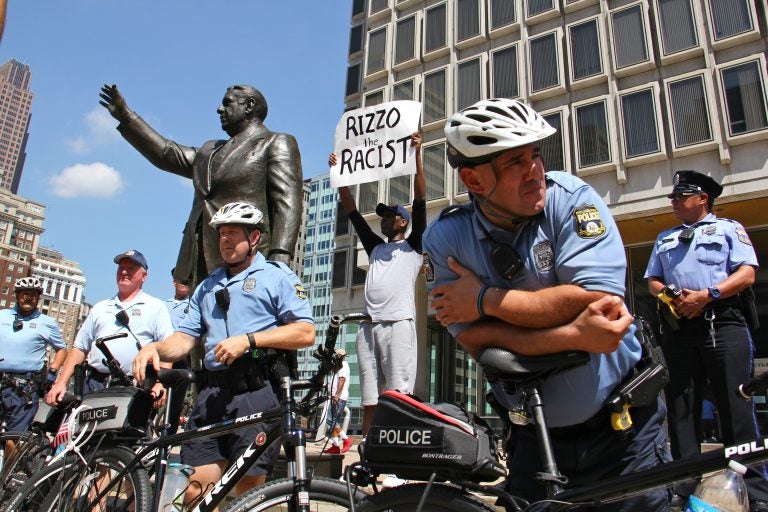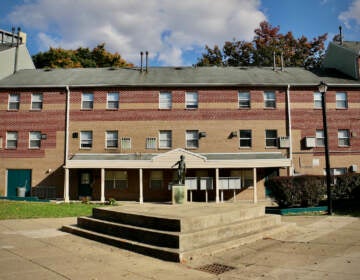Destination unknown: Philly to move Rizzo statue
The statue has been a polarizing public artwork for years, with critics calling for its removal, given Rizzo’s record on police brutality, especially in communities of color.
Listen 0:00
Philadelphia police protect the Frank Rizzo statue during a protest on August 12, 2016.(Emma Lee/WHYY)
Philadelphia officials announced Friday that the city will remove the controversial statue of the late mayor and police commissioner Frank Rizzo, whose bronze likeness across from City Hall has prompted protests and vandalism from critics who revile him as a racist.
The statue, which has stood on the steps of Thomas Paine Plaza since 1998, will be moved to an as-yet undetermined location, city Managing Director Michael DiBerardinis said. The decision to move the statue came after the city solicited ideas from the public on what to do with it. That effort drew nearly 4,000 submissions, including a few eyebrow-raising suggestions.
“We thank the citizens of Philadelphia for responding with such thoughtful ideas,” the city’s chief cultural officer Kelly Lee said. “The response was very helpful for us to identify a host of potential new locations. We plan to do our due diligence on these locations before announcing the new site, but the input helped shaped some of the options we’ll review. Our goal moving forward is to seamlessly relocate the statue to a new, more appropriate public location in the city.”
Removing the statue comes as officials mull how to make Paine Plaza “a new type of inviting and engaging public space,” said DiBerardinis. “We are working to plan and create a public space more in line with neighboring Dilworth Plaza and the soon-to-be unveiled Love Park.”
The city next will conduct feasibility studies to determine where the statue should be relocated, DiBerardinis said. The city will then seek removal and relocation approval from the Art Commission. Officials expect formulating that plan will take at least 6 months.
The statue has been a polarizing public artwork for years, with critics calling for its removal, given Rizzo’s record on police brutality, especially in communities of color.
Frank Rizzo, Jr. says he’s surprised and upset about the decision, especially how the Kenney administration let people know through a press release.
“My Mom’s 101 years old and this isn’t how she should hear about it,” Rizzo said. “She was very anxious about the outcome here and I don’t think it was a very classy way to make this announcement. I’m disappointed. I don’t think this drastic a move is necessary.”
Joe Mastronardo, Rizzo’s only grandchild, was 9 when his grandfather died.
He remembers his “PePop” as a man who faithfully came to all his school functions, brought him along on weekend trips to Atlantic City, and even sometimes put him on the air of his “Frank Talk” radio show on 1210-WCAU.
He called his grandfather’s reputation as a racist bully “nonsense.”
“I feel like they’re attacking someone in the most cowardly way possible. There needs to be some kind of fight against this. This is a case of pandering. It’s not a good place to be where nonsensical public pressure and a lot of hypocrisy is dictating the outcome of certain debates,” said Mastronardo, 35, of Huntingdon Valley. “I would love to say this is just a statue, and it doesn’t matter, and blah blah blah blah. But if you look at the big picture, it’s disappointing, and it’s a sad thing, when you look at how much he gave to the city. It really gives you a glimpse of where we are as a country, when you give in to this type of revisionist history that’s based on nonsense.”
Mastronardo said he hadn’t really thought about the city’s quest for “a more appropriate public location” for the statue.
“It should stay exactly where it is,” he said. “If anything, it should be (moved to) the steps of City Hall, because that’s what my grandfather’s life represented. My grandfather was dedicated to this city. He gave his life for it. Everything about him was about this city and making things better and keeping people safe.”
Zenos Frudakis, who sculpted the statue, said he was disappointed city officials excluded him from discussions on the statue’s fate.
“I’m disappointed that I wasn’t brought in to be part of the discussion since I sculpted Frank Rizzo, and also … because I’ve done over 100 over-lifesize figures that are all around the world. I don’t say that to brag, but I have a certain expertise.
“Even if I hadn’t sculpted it, I think I have information about sculpture and installation and all of that. And I wasn’t part of the deliberations.”
Frudakis worried what precedent removing the Rizzo statue might set for other public art citizens might find objectionable for one reason or another.
“This started with the Confederate soldiers, and somehow this has been tossed in. It’s like the French Revolution: Once the heads start rolling, how many bronze heads will remain,” Frudakis asked.
Still, plenty of others applauded the move.
“It celebrates a racist bigot and a homophobe. That’s exactly what Frank Rizzo was,” said Asa Khalif, an organizer with Black Lives Matter. “It also represents the spirit that allowed him to operate in a brutal way, especially brutality toward black and brown people and LGBT people. It represented and celebrated white supremacy and police brutality and police violence.”
Khalif didn’t mind that the statue would be moved — instead of mothballed or destroyed.
“I always said they should throw it in the river or somewhere, the incinerator, (but) I didn’t care where they placed it as long as it was off taxpayers’ property,” Khalif said. “This (where the statue is now) is city property that’s paid for by the taxpayers, so move it to a museum, move it to his grandson’s backyard, move it to some of his cronies that he dealt with in the past. Who cares! As long as it was off of public property.”
City Councilwoman Helen Gym also called the planned removal a good move.
“In August, I called for the statue to be relocated, because I believe Frank Rizzo belongs to history,” she said in a statement her office issued Friday afternoon. “He tells us a lot about who Philadelphia was, and now our public spaces tell a different story about who we aspire to be and what our future holds for us.
“I was not the first to call for the statue’s removal. This conversation has been going on for years, and I commend the many groups who have raised their concerns to move this issue — you were heard. Relocating the statue is not and has never been about erasing history. It’s about acknowledging how complex and complicated our history is, and being thoughtful and deliberate about what images we uphold in our public spaces.
“The conversations about the Rizzo statue have always been part of a larger dialogue centering on the integrity and importance of our public spaces and making them welcoming and inclusive for our city’s most vulnerable.”
WHYY is your source for fact-based, in-depth journalism and information. As a nonprofit organization, we rely on financial support from readers like you. Please give today.





